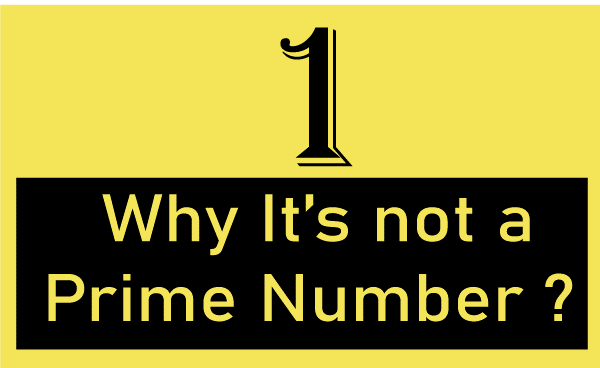Is 1 a Prime Number?Prime NumberA prime number is greater than 1, and its factor involves 1 and itself. Those numbers that do not fit into this definition can be regarded as Composite Numbers. Composite numbers are just contrary to the Prime number. 
Facts Related to Prime NumbersEven Prime Number: It is interesting to note that 2 is the only even prime number, and a rest series is an odd number; therefore, it is referred to as an Odd Prime number. Co-Prime Number: Two numbers can be regarded as a co-prime number if they have the highest common factor as 1. Co-Prime numbers and Prime numbers do not equal. Methods to Find Prime NumbersMethod 1 Each prime number can be expressed in the form of 6n + 1 and 6n - 1 (except the multiples of prime numbers 2, 3, 5, 7, 11 ) Method 2 To find the prime number, which is greater than 40, the formula which can be used: n2 - n + 41 where n = 0, 1, 2, .... 39 example includes
Question: Is 1 a Prime Number? Answer: The simple answer to the question is that No. 1 is neither a composite nor a Prime number. It is because 1 has a positive divisor as 1 and itself. Prime numbers have two positive divisors. 2 is the smallest prime number, filling the condition of being a prime number. Question: If 1 is not a prime number, then what is 1 called? Answer: There are various categories in which 1 comes in, and the following categories may be called:
Whole Number: Whole numbers consist of all the natural numbers and include zero. For example, 0, 1, 2, 3 ... Natural Number: A number system begins from 1 and ends at infinity. Examples include 1, 2, 3, 4.... Rational number: Those numbers that can be presented in p/q form are called Rational numbers. Positive Number: Those numbers are positive and greater than zero. They are sometimes represented with a + symbol. The positive number is represented on the right side of the number line. Even if no symbol is attached, it is perceived as a positive number. Odd number: Numbers not divisible by two are categorized as odd numbers, and the algebraic expression used to express odd numbers is 2n + 1. Some examples of odd numbers include 1, 3, 5, 7, and 9 .... Question: Why does 1 not come in the category of Composite Numbers? Ans: The simple answer to this question is that it does not satisfy the definition of the composite number. A composite number contains more than 2 positive numbers. But the 1 contains only a factor, and it is itself. Therefore, 1 does not come in the category of a composite number. Facts Related to Prime NumbersThe polynomial n2 ? n+ 41 discovered by Euler gives a prime number for the values of n, which lies between 0 and 39 inclusive. It can produce 40 prime numbers for 0 < = n < = 39. Quick Summary Question 1. Is 1 a prime number? Answer: No, it isn't a prime. Question 2. Is 1 a composite number? Answer: No, it isn't a composite number. Question 3. Determine the factors of 1. Answer: The factors of 1 contain 1, i.e., 1. Similar Related Question Question: Is 1 a perfect square? Answer: Yes, 1 is a perfect square. It can be illustrated as 1 x 1 = 1. Question: What are the multiples of 1? Ans: Multiples of include 1, 2, 3, 4, 5, 6, 7, 8, 9, 10. . . Question: What is the cube root of 1? Ans: The cube root of 1 is 1. It can be illustrated as 1 x 1 x 1 = 1. Question: Is 1 a perfect cube? Answer: Yes, 1 is a perfect cube.
Next TopicTables 1 to 20
|
 For Videos Join Our Youtube Channel: Join Now
For Videos Join Our Youtube Channel: Join Now
Feedback
- Send your Feedback to [email protected]
Help Others, Please Share









